Related Research Articles

The Mercedes-Benz Mannheim 350 replaced the W03/Typ 350 models in 1929. The structure originated by Ferdinand Porsche was modified by Hans Nibel.

The Mercedes-Benz 380 is an eight-cylinder powered automobile introduced by the German manufacturer Mercedes-Benz at the Berlin Motor Show in February 1933. It was withdrawn from production during 1934. Several models with similar names were produced by Mercedes-Benz during the 1930s, so that in retrospect the car is frequently identified using the manufacturer's Works Number as the W22.
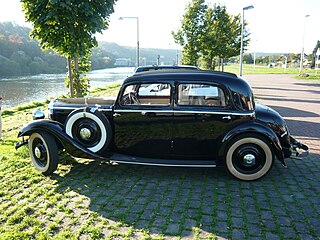
The Mercedes-Benz W 21 was a six-cylinder passenger car launched in 1933 using the name Mercedes-Benz Typ 200. It was one of several Mercedes-Benz models known, in its own time, as the Mercedes-Benz 200 and is therefore in retrospect more commonly referred to using its Mercedes-Benz works number, “W21”.

The Mercedes-Benz W 142 was a six-cylinder passenger car launched in February 1937, as a successor to the Mercedes-Benz Typ 290. The car was known by its name Typ 320 at the time of its production and service, but is in retrospect commonly referred to using its Mercedes-Benz works number, "W142", which gives a more unambiguous, unique nomenclature.
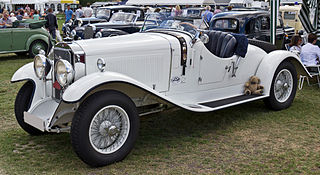
The Mercedes-Benz W08 was a large luxury car produced by Daimler-Benz. It was introduced in Autumn 1928, as Mercedes-Benz's first eight-cylinder passenger car. Also known by various “type numbers”, it remained in production with various modifications and upgrades until the later summer of 1939, the longest lived Mercedes-Benz model of the 1920s and 1930s.

The Mercedes-Benz W18 was a six-cylinder automobile introduced as the Mercedes-Benz Typ 290 in 1933. It was a smaller-engined successor to the manufacturer’s Typ 350 / 370 Mannheim model. In terms of the German auto-business of the 1930s it occupied a market position roughly equivalent to that filled by the Mercedes-Benz E-Class in the closing decades of the twentieth century. The W18 was replaced in 1937 by the manufacturer’s W142.

The Benz 10/25 PS was a midsize automobile introduced by Benz & Cie in 1912. The same year stated maximum output was increased which meant a name change to Benz 10/30 PS. The model disappeared for three years following the First World War but returned in 1921. A further power increase in 1926 meant another name change, now to Benz 10/35 PS. Following the "fusion" between the Daimler and Benz companies, production of the Benz 10/35 PS ended in 1927.
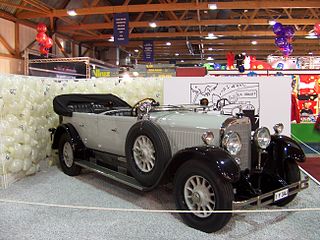
The Mercedes 15/70/100 PS was a large automobile introduced by Daimler in 1924. Production continued till 1929 by which time Daimler had merged with Benz & Cie as a result of which the car's name had changed to Mercedes-Benz Typ 400.

The Mercedes 24/100/140 PS was a large luxury car introduced by Daimler of Untertürkheim in 1924. Production continued until 1929 by which time Daimler had merged with Benz & Cie and the car's name changed to Mercedes-Benz Typ 630. The car was conceptually and structurally similar to the contemporary Mercedes 15/70/100 PS, but the 24/100/140 PS was longer, heavier, more powerful, faster and more expensive.

The Mercedes-Benz W02 was a midsize six-cylinder two-litre-engined automobile introduced by Daimler-Benz at the Berlin Motor Show in October 1926. It was developed in some haste under the manufacturer's Technical Director, Ferdinand Porsche in parallel with the smaller Mercedes-Benz W 01 and the larger three-litre-engined Mercedes-Benz W03 following the creation of Daimler-Benz, formally in July 1926, from the fusion of the Daimler and Benz & Cie auto-businesses.
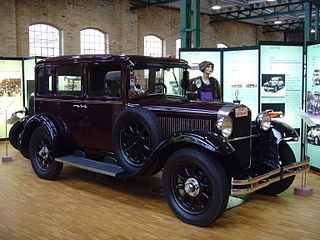
The Mercedes-Benz W11 was a midsize six-cylinder automobile introduced by Daimler-Benz it 1929. It was developed from the Mercedes-Benz W02 first seen in 1926, and the W11 shared its chassis and bodywork with the W02, but the W11 came with a larger more powerful engine, a new name and a wider list of “standard bodies” from which customers could choose.

The Mercedes-Benz W03 was a large six-cylinder-engined automobile introduced as the Mercedes-Benz 12/55 PS and, initially, as the Mercedes-Benz Typ 300, by Daimler-Benz at the Berlin Motor Show in October 1926. It was developed in some haste under the manufacturer's Technical Director, Ferdinand Porsche in parallel with the smaller Mercedes-Benz W 01 and the two-litre-engined Mercedes-Benz W02 following the creation of Daimler-Benz, formally in July 1926, from the fusion of the Daimler and Benz & Cie auto-businesses.
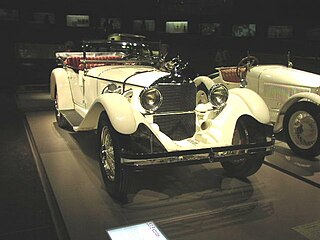
The Mercedes-Benz S-Series (W06) was a successful line of sports cars produced from 1927-33 that bore the nickname, the "white elephants."
The Mercedes-Benz M08 engine is a naturally-aspirated and supercharged, 4.6-liter and 5.0-liter, straight-8 engine, designed, developed and produced by Mercedes-Benz; between 1928 and 1940.
The Mercedes-Benz M23 engine is a naturally-aspirated, 1.3-liter, inline-4 gasoline engine, designed, developed and produced by Mercedes-Benz; between 1933 and 1936.
The Mercedes-Benz M21 engine is a naturally-aspirated, 2.0-liter, straight-6, internal combustion piston engine, designed, developed and produced by Mercedes-Benz; between 1933 and 1936.
The Mercedes-Benz M06 engine is a supercharged, 6.8-liter to 7.1-liter, straight-6, internal combustion piston engine, designed, developed and produced by Mercedes-Benz; between 1928 and 1934.
The Mercedes-Benz M04 engine is a naturally-aspirated, 3.0-liter and 3.1-liter, straight-6, internal combustion piston engine, designed, developed and produced by Mercedes-Benz; between 1927 and 1928.
The Mercedes-Benz M02 engine is a naturally-aspirated, 2.0-liter, straight-6, internal combustion piston engine, designed, developed and produced by Mercedes-Benz; between 1926 and 1933.
The Daimler-Mercedes M9456 engine is a supercharged and naturally-aspirated, 6.2-liter to 6.4-liter, straight-6, internal combustion piston engine, designed, developed and produced by Mercedes-Benz, in partnership with Daimler; between 1924 and 1929.
References
- ↑ "Mercedes-Benz M11 Engine". Sportlichleicht.com. Retrieved 10 November 2021.
- ↑ "MERCEDES BENZ Typ Stuttgart 260 (W11) specs & photos - 1929, 1930, 1931, 1932, 1933, 1934". Autoevolution. Retrieved 10 November 2021.
- ↑ "MERCEDES BENZ Typ Stuttgart 260 Cabriolet A (W11) specs & photos - 1929, 1930, 1931, 1932, 1933, 1934". Autoevolution. Retrieved 10 November 2021.
- ↑ "Mercedes-Benz W11 Roadster 1929". Xar.info. Retrieved 10 November 2021.
- ↑ "8/38 hp and Stuttgart 200 / 260 (W 02, W 11), 1926 - 1936". Mercedes-benz-publicarchive.com. Retrieved 10 November 2021.
- ↑ Oswald, p 219